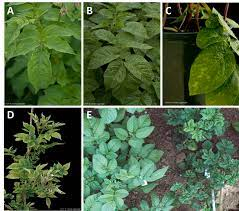Potato Virus D (PVD) is a serious threat to potato production worldwide, causing significant yield losses and economic damage. In this article, we will discuss the symptoms, transmission, and control strategies for PVD based on the latest research and data available.
Potato Virus D (PVD) is a member of the Potato Virus Y (PVY) group and belongs to the genus Potyvirus. PVD is transmitted by aphids, but can also spread through infected seed tubers, mechanical transmission, and grafting. The symptoms of PVD include mosaic patterns, leaf curling, stunted growth, and yield reduction. Once infected, the virus cannot be eliminated from the plant, and can persist in the field through weed hosts.
To control the spread of PVD, growers should use certified seed tubers and avoid planting in fields with a history of PVD. It is also important to control aphid populations through cultural practices and the use of insecticides. Additionally, crop rotation, removing weed hosts, and destroying infected plants can reduce the spread of PVD. Early detection and eradication of infected plants can also be effective in controlling the disease.
In conclusion, PVD is a significant threat to potato production and can cause significant economic damage. However, with proper management practices, including the use of certified seed tubers, controlling aphid populations, and removing infected plants, growers can reduce the impact of PVD and protect their potato crops.
#PotatoVirusD #PVD #PotatoProduction #PlantDisease #Aphids #SeedTubers #CropManagement #Insecticides #WeedControl #Eradication

